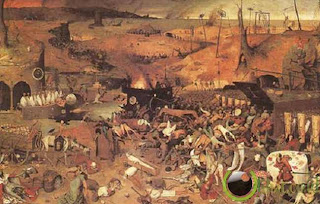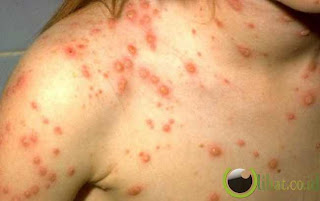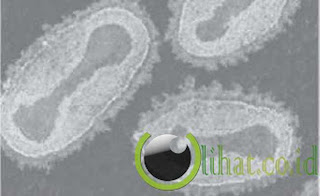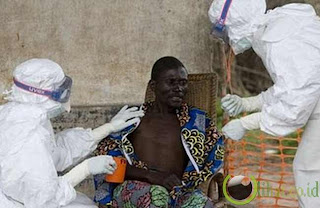Technological advances in the field of biology has been able to utilize many types of microorganisms to produce goods and services for human well-being. This is one area of genetic engineering. An example is the use of certain viral gene transplant, or insulin-making with the help of E. coli.
But do you know that the era before the existence of known microorganisms, the microbial pathogens has led killed millions of lives because of the illnesses they cause. Even today the pathogenic microbes start to bacterial virus still cause disease thrilling and unpredictable. Follows: 10 Outbreak Has Killed Millions of people in the World
1. The Black Death


The Black Death (Black Death) or The Black Plague (Black Plague), is one of the deadliest pandemics in human history. The outbreak is expected to start from Central Asia and then spread to Europe around the 1340s. The total number of deaths worldwide due to the pandemic is estimated at 75 million people! Even death is expected to reach 20 to 30 million just in Europe alone. The Black Death is estimated to have killed between one-third to two-thirds of the human population in Europe.
dangerous disease is caused by the bacterium Yersinia pestis. Human Yersinia pestis infection have developed three major diseases: pneumonia (pneumonia), septicemia (blood poisoning), and pes. Three forms of the disease is believed to have been responsible for a number of high-mortality epidemics throughout human history. It is now known conclusively that these plagues originated from animal populations in China.
recently, Yersinia pestis has gained serious attention because it can be used as a biological warfare agent. By the CDC (Center for Disease Control) the United States has been classified as a category A pathogen requiring significant attention to the possibility exploited by terrorists.
2. Polio


Polio (also called poliomyelitis) is a contagious disease that has devastated the human population in the Western hemisphere in the second half of the 20th century.Although polio has plagued humans since ancient times, the most extensive outbreak occurred in the first half of the 1900s before the vaccination created by Jonas Salk, and has been widely available in 1955.
polio paralysis is a disease of the limbs, usually the legs, caused by a virus . Approximately 95% of cases have no symptoms at all (asymptomatic polio). In 4% - 8% of cases in which there are symptoms (called symptomatic polio), appears in three forms: a mild form, called polio which failed. Most people who suffer from this type do not suspect that they are infected with polio, because the symptoms are mild flu-like symptoms, such as mild upper respiratory infections, diarrhea, fever, sore throat, and a general feeling of being ill. Nonparalytic polio is polio causes paralysis. The more serious form associated with aseptic meningitis due.Approximately 1% - 5% show neurological symptoms such as sensitivity to light and neck stiffness. Paralytic polio, a cause polio paralysis. It occurs in 0.1% -2% of cases. Starts transmission of the virus that enters the intestinal tract, enter the blood stream, and then strike a nerve. At that failed or asymptomatic polio, the virus usually does not get past the intestinal tract.
virus can affect the nerves that control the muscles in the legs and respiratory muscles, causing respiratory difficulty and paralysis of the arms and legs. High infection in the spinal cord or in the brain may increase the risk of respiratory problems and lead to death. Polio virus has killed more than 10,000 people around the world starting in 1916 until now polio sufferers
3. Smallpox (Variola vera)


Smallpox is a serious contagious disease and is sometimes fatal. There is no specific cure for smallpox. That there is only prevention through vaccination.
There are two clinical forms of smallpox. Variola major (big) is the most common and severe form, characterized by extensive skin rash and high fever. Historically, variola major has an overall mortality rate of approximately 30%, however, the bleeding that occurs can be fatal. Variola minor is a less common form of smallpox.This type is less severe, with death rates historically of 1% or less.
Infection occurs through inhalation (breathing) variola virus in the air, fluid or mucus from the mucosa of the mouth, nose, or pharynx of infected people. Transmission from one person to another, especially when adjacent to an infected person, usually within a distance of about 1.8 m, but can also be spread through direct contact with body fluids or contaminated objects (fomites) such as bedding or clothing. Very rare airborne smallpox virus spreading in enclosed spaces such as buildings, buses, and trains. This disease comes from South America in the 18th century and from time killing more than 60 million people. Patients with smallpox variola (smallpox pus)
4. Cholera


Cholera is an intestinal infection caused by the bacterium Vibrio cholerae. The main symptoms are diarrhea and vomiting. Transmission primarily through drinking water or eating contaminated food. Severity of the diarrhea and vomiting can lead to dehydration and electrolyte imbalance. Primary treatment with oral rehydration solution and if these can not handle it then it must be done intravenous injection of a liquid electrolyte. Antibiotics may be given to patients with severe conditions.Estimated cholera has frequently infecting humans for centuries. Reports of disease outbreaks like cholera are found in India since 1000 AD. Cholera is a term derived from the Greek Khole (disease of the bile) and then in the 14th century called colere (France) and choler (UK). In the 17th century, cholera is a term used to describe a severe digestive disorders involving diarrhea and vomiting
5. Ebola


This deadly virus named after the Ebola River Valley in the Democratic Republic of Congo (formerly Zaire), which is the location of the outbreak was first discovered in 1976, at a missionary hospital run by Flemish nuns. Cases of this virus caused largely remained unclear until 1989, when a widely publicized outbreaks occurred in some monkeys in the United States.
The common symptoms are rash, red eyes, hiccups and internal and external bleeding may be seen in some patients. When the rash appears on the skin dark, often not visible until the rash begins to peel. In pregnant women, abortion (miscarriage) and heavy bleeding vaginally including common symptoms of Ebola. Death usually occurs during the second week. Death in Ebola victims is usually caused due to massive blood loss.
Ebola virus is transmitted by direct contact with body fluids, blood, and tissue of an infected person. Transmission of Ebola virus has also occurred in the handling of animals or people who are sick or dying. Commonly infected wild animals are chimpanzees, gorillas, monkeys, forest antelope, fruit bats. This disease killed more than 160,000 people from 1976 to 2000.
6. Malaria

Malaria is caused by a parasite called Plasmodium, which is transmitted through the bite of the Anopheles mosquito. In the human body, the parasites multiply in the liver, and then infect red blood cells. The parasites multiply within red blood cells, which then rupture within 48 to 72 hours, then Plasmodium would infect other red blood cells. The first symptoms usually occur 10 days to 4 weeks after infection, although it can also appear atu 8 days or years after infection. This disease occurs due to the inclusion of a large number of merozoites (early stage form of Plasmodium that are transmitted by mosquitoes) into the blood stream, resulting in anemia due to destruction of red blood cells, and the problems caused by the large number of free hemoglobin released into the circulation after rupture of blood cells red (sporulation). Malaria due to infection with P. falciparum, if not promptly treated, can rapidly develop into severe malaria. The main symptoms of severe malaria include: coma, severe breathing difficulties, low blood sugar, and low blood hemoglobin (severe anemia). It is diagnosed by the presence of parasites P. falciparum and one of the above symptoms with no other obvious cause. Children are particularly vulnerable because they have fewer immune sit.
If left untreated, severe malaria can cause death.
Till now malaria continues to kill people every day "exactly 2,800 children every day! And about 2.7 million people per year!
7. Plague

People usually suffer from the bubonic plague because mice bitten by fleas that carry the bacteria Pasteurila pestis. These outbreaks still occur in rural communities or in cities, especially those commonly associated with rats and rat fleas.
Symptoms of bubonic plague are high fever, chills, headache, weakness, and pain in the gut.
Outbreaks of this ever happened in the 1300 AD and killed more than 250 million people!
8. Spanish Flu


Influenza pandemic of 1918-1919 killed more people than the deaths in World War I (WW I), between 20 and 40 million people. It has been noted as the most devastating epidemic in world history. More people died of influenza in a single year than four years of the Black Death bubonic plague from 1347 to 1351. Known as "Spanish Flu", influenza of 1918-1919 was a global disaster. This virus attacks with amazing speed, often killing its victims within hours of the first signs of infection. This disease causes deadly pneumonia secondary infections and uncontrolled bleeding which causes the lungs to meet. In the early 1990s, 75 years of research conducted has failed to answer the question of why this most fatal Spanish flu occurred. Since 1918 there are no viruses that can be isolated. In just two years the virus killed more than 100 million people.
9. Influenza (virus RNA)

Influenza, commonly referred to as the flu, is an infectious disease caused by RNA viruses of the family Orthomyxoviridae, which can attack the birds and mammals.The most common symptoms of the disease are chills, fever, sore throat, muscle pains, severe headache, coughing, weakness / fatigue and general discomfort.Influenza can cause nausea and vomiting, especially in children, but these symptoms are more common in gastroenteritis. Flu sometimes can cause pneumonia.Usually influenza is transmitted through the air by coughing or sneezing. Influenza can also be transmitted by direct contact with bird droppings or nasal secretions (mucus), or by contact with contaminated surfaces. Virus that has killed 36,000 people is expected to spread starting in 1918 or 1919 to Asia and Europe via Africa.
10. AIDS

Syndrome of acquired immunodeficiency syndrome (AIDS) is an acquired immune deficiency, a disease of the human immune system caused by the human immunodeficiency virus (HIV). The virus attacks the immune system and causes the body vulnerable to a variety of secondary infections and cancer. Common bacteria, fungi, parasites, and viruses that normally do not cause serious illness in people with healthy immune systems, can cause fatal disease in people with AIDS.HIV is found in saliva, tears, nervous system tissue and spinal fluid, blood, semen (including pre-seminal fluid, which is fluid that comes out before ejaculation), vaginal fluid, and breast. However, only blood, semen, vaginal fluids, and breast milk generally transmit infection to others.
virus can spread through ways:
- Through sexual contact "including oral sex, vaginal, and anal
- Through blood "through blood transfusions or needle
- From mother to child "a pregnant woman can transmit the virus to her fetus through the bloodstream, or nursing mothers can transmit to her baby through her breast milk.
Until now there is no cure for AIDS. Existing drugs is to inhibit viral replication. The only way to stay safe is to know how HIV is transmitted and how to prevent HIV infection.
SOURCE :
http://wisbenbae.blogspot.com/2013/03/7-wabah-yang-membunuh-jutaan-manusia.html
http://terselubung.blogspot.com/2013/03/10-wabah-yang-membunuh-jutaan-manusia.html
Tidak ada komentar:
Posting Komentar